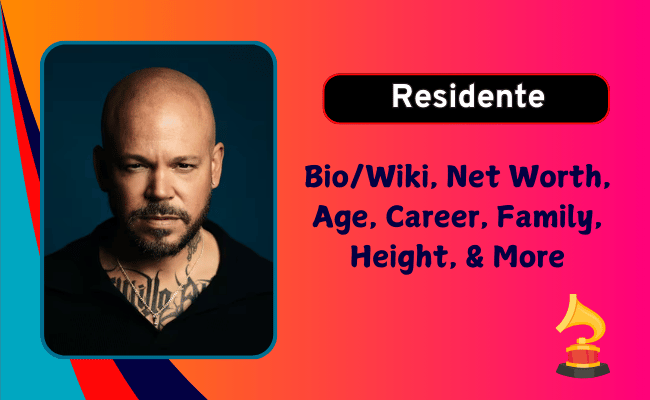Residente, born René Pérez Joglar on February 23, 1978, in Hato Rey, Puerto Rico, is a Puerto Rican rapper, singer, songwriter, filmmaker, and activist. He gained worldwide recognition as the co-founder of Calle 13, an alternative rap group that redefined Latin urban music. With four Grammy Awards and a record 29 Latin Grammy Awards, Residente is one of the most awarded Latin artists in history.
Beyond music, he is known for his outspoken political views, activism, and humanitarian work, advocating for education, indigenous rights, and social justice. In 2025, Residente won the Grammy Award for Best Música Urbana Album for his second solo project Las Letras Ya No Importan, breaking Bad Bunny’s Grammy streak.

In this article, we will explore Residente’s net worth, age, height, weight, career, early life, family, relationships, and lesser-known facts.
Residente Short Details
| Attribute | Details |
|---|---|
| Full Name | René Pérez Joglar |
| Stage Name | Residente |
| Profession | Rapper, Singer, Songwriter, Filmmaker, Activist |
| Hometown | Hato Rey, Puerto Rico |
| Nationality | Puerto Rican |
| Date of Birth | February 23, 1978 |
| Age (as of 2025) | 46 years old |
| Height | 5 feet 9 inches (175 cm) |
| Weight | Approx. 165 lbs (75 kg) |
| Eye Color | Brown |
| Hair Color | Bald |
| Zodiac Sign | Pisces |
| Genres | Alternative Hip-Hop, Urban, Reggaeton, Latin Trap, World Music |
| Years Active | 2004 – Present |
| Labels | Sony Latin |
| Notable Works | Residente, Multi Viral, Las Letras Ya No Importan |
Early Life and Education
Residente was born to Flor Joglar de García, an actress, and Reinaldo Pérez Ramírez, a labor lawyer, musician, and writer. His parents were deeply involved in Puerto Rican independence movements, which influenced his political activism.
- He grew up in Trujillo Alto, Puerto Rico, surrounded by music, art, and sports.
- He played baseball and was a drummer in his school band.
- He attended the Escuela de Artes Plásticas (School of Visual Arts) in San Juan, where he obtained a Bachelor of Fine Arts degree.
- He later earned a Master’s degree in Fine Arts from Savannah College of Art and Design (SCAD), Georgia, USA.
While studying in Spain, Residente experimented with film and music, creating a short film S=emp2. After struggling to find work, he returned to Puerto Rico, where he started writing lyrics and collaborating with his stepbrother Eduardo Cabra (Visitante).
Career Highlights and Achievements
Calle 13: The Rise to Fame (2004–2014)
- In 2004, Residente and Visitante formed Calle 13, blending hip-hop, reggaeton, rock, and Latin music.
- Their self-titled debut album Calle 13 (2005) included hits like “Atrévete-Te-Te” and “Se Vale Tó-Tó”, bringing them widespread fame.
- They won their first Latin Grammy in 2006, followed by Los de Atrás Vienen Conmigo (2008), which won Album of the Year.
- Multi Viral (2014) was their most political album, featuring collaborations with Julian Assange, Tom Morello, and Kamilya Jubran.
After five studio albums, Calle 13 became one of the most influential Latin music acts, but Residente decided to pursue a solo career in 2015.
Solo Career and Global Influence (2017–Present)
- In 2017, Residente released his debut solo album Residente, inspired by a DNA test tracing his ancestry.
- The album, recorded in Burkina Faso, China, Siberia, and Armenia, won Best Urban Music Album at the Latin Grammys.
- His 2020 single “René” was a deeply personal song about mental health and depression.
- He collaborated with Bad Bunny on “Bellacoso” (2019) and “Afilando los Cuchillos” (2020), a song protesting against Puerto Rico’s governor.
- In 2025, his second solo album Las Letras Ya No Importan won Best Música Urbana Album at the Grammys, featuring artists like Busta Rhymes, Rauw Alejandro, and Christian Nodal.
Filmmaking and Activism
- Directed documentaries like Sin Mapa (2009) and Residente (2017).
- Created 1868 Studios, a partnership with Sony Music Entertainment to develop films about Latin American culture.
- Released “Antes Que El Mundo Se Acabe” (2020), a song about global unity during COVID-19.
Family and Relationships
| Family Member | Role |
|---|---|
| Father | Reinaldo Pérez Ramírez (Lawyer, Musician) |
| Mother | Flor Joglar de García (Actress) |
| Stepbrother | Eduardo Cabra (Visitante, Calle 13) |
| Half-Sister | Ileana Cabra (Singer, iLe) |
| Cousin | Lin-Manuel Miranda (Composer, Hamilton) |
| Ex-Wife | Soledad Fandiño (m. 2013, div. 2017) |
| Current Partner | Kasia Marciniak (2017–Present) |
| Children | Milo Pérez (Son, born 2014) |
Physical Appearance
| Attribute | Details |
|---|---|
| Height | 5 feet 9 inches (175 cm) |
| Weight | Approx. 165 lbs (75 kg) |
| Eye Color | Brown |
| Hair Color | Bald |
Residente Net Worth & Income Sources
As of 2025, Residente’s estimated net worth is $35–$40 million, accumulated through:
- Music Sales & Streaming
- Concert Tours & Live Performances
- Film & Documentary Projects
- Brand Partnerships & Endorsements
| Category | Details |
|---|---|
| Net Worth | $35–$40 Million (Estimated) |
| Primary Income | Music, Streaming, Concerts |
| Additional Income | Filmmaking, Endorsements |
Lesser-Known Facts About Residente
- He has the most Latin Grammy Awards (29) in history.
- He has been diagnosed with autism and ADHD, which he revealed in his 2017 song Mis Disculpas.
- He is Lin-Manuel Miranda’s cousin.
- His first film, Residente, won awards at international film festivals.
- He was censored in Puerto Rico for three years after insulting the governor.
- He co-wrote the 2023 film Porto Rico.
- He is an outspoken advocate for Palestine, featured in his song Bajo los Escombros.
- He studied fine arts for eight years before starting his music career.
- He once exchanged concert tickets for food donations.
- His song La Cátedra is the longest rap diss track, lasting 12 minutes.
Conclusion
Residente is not just a musician, but a cultural icon, activist, and filmmaker. From winning multiple Grammys to challenging political oppression, he continues to push boundaries in music, film, and social justice. With a net worth of $40 million and a career spanning over two decades, he remains one of the most influential voices in Latin America.
“NOTE: This article is based on publicly available information and is intended for informational purposes only. Readers are advised to verify the details independently from reliable sources.”
